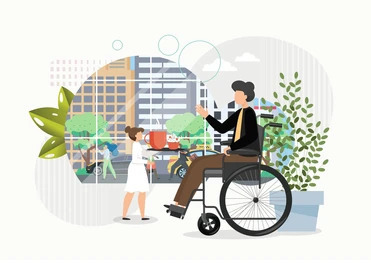
Achieving Universal Accessibility in Indian Cities
New guidelines for ‘accessibility standards’ a step forward but not enough
Urban planning in India fails to account for the needs of various marginalised groups in the city, notably persons with disabilities, making cities inaccessible and exclusionary to them. Addressing this, the Ministry of Housing and Urban Affairs (MOHUA) released the Harmonised Guidelines and Standards for Universal Accessibility in India, 2021 (Guidelines). These guidelines revise an earlier version issued in 2016, and are an important step in making India’s cities truly inclusive for all, based on the principle of ‘leaving no one behind.’
The accessibility standards prescribed under the Guidelines are applicable to all public buildings, i.e. buildings where access is open to the public at large (whether they are publicly or privately-owned) as mandated by the Rights of Persons with Disabilities Act, 2016 (RPWDA). This article critically examines the approach adopted by the Guidelines towards making cities accessible to all, and the steps necessary for its proper implementation.
Adopting a ‘Universal Design’ approach
The Guidelines set out standards for achieving ‘universal accessibility’, i.e., every person irrespective of gender, age, caste, ability, health condition or socio-economic background will enjoy an equal opportunity to function independently and participate in society. For this, the Guidelines identify the diverse range of users, their particular needs, and consequently, set out key elements of the built environment along with accessibility specifications for various parts of the built environment. This marks a decisive and welcome shift, from the previously adopted ‘minimum compliance approach’ that only focused on certain categories of urban users, i.e., persons with disabilities and the elderly, towards a more comprehensive, universal approach, aimed at making the built environment accessible for all.
The Guidelines adopt a ‘universal design’ perspective for achieving accessibility. Universal design means “the design of products and environment to be usable by all people, to the greatest extent possible, without the need for adaptation or specialised design.” The Guidelines, however, note that the concept of universal design must be adapted to the Indian context and therefore, the design of any built environment must be equitable, usable, cultural, economic and aesthetic, with emphasis on a participatory approach. Consequently, while laying down accessibility elements, the Guidelines also discuss the plurality of factors peculiar to India, such as, geography, tradition and culture, climate, language, living conditions, among other things, demonstrating a progressive approach, as planning processes typically consider only ‘young, able-bodied men’ as users of urban space.
The Guidelines align with the Sustainable Development Goal 11, which focuses on “making cities and human settlements inclusive, safe, resilient and sustainable.” This requires Master Planning to adopt a rights-based, human-centred urbanism which ensures that cities are accessible to women, children, persons with disabilities and other vulnerable groups in the city.
It is important to keep in mind the multiplicity of socio-economic and cultural factors at play that render certain groups in the city, such as women with disabilities, disproportionately vulnerable to discrimination, unsafety and barriers to access. Therefore, it is necessary to adopt a feminist, cross-disability perspective to ensure that the ‘universal accessibility’ approach works for a diverse range of urban users, in line with the principle of ‘planning from the margins,’ espoused by the New Urban Agenda (2016).
Lack of Focus on Psychosocial Disabilities
The impact of the built and social environment in urban areas on mental health outcomes is well documented. Research suggests that exposure to natural environments through access to urban green spaces is beneficial to persons with mental illnesses and provides symptom relief for a range of mood disorders and other stress-related issues. The concept of ‘restorative urbanism’ places mental health, wellness and quality of life at the forefront of city planning and design of urban spaces for the purpose of fostering healthy cities. There is an urgent need to integrate such research into the development and revision of accessibility standards, a missed opportunity for the Guidelines.
However, there is a notable lack of focus on psychosocial disabilities in the Guidelines, specifically, accessibility needs in urban space. The RPWDA specifies mental illness as a form of disability, however, the Guidelines pay little to no attention to the needs of persons with psychosocial disabilities in the context of accessibility to urban infrastructure and planning.
Incorporating ‘Universal Accessibility’ in local contexts
The Guidelines advocate for adopting a Universal Design approach end-to-end, viz. from inception through implementation, operational as well as maintenance phases. ‘Universal accessibility’ must be incorporated in not only macro and micro scales of planning but continuously in the planning process. While the Guidelines represent a step forward, their implementation rests in the hands of the States, Union Territories and cities. The key task for different States and cities is to integrate these Guidelines into state-level planning laws, local building bye-laws and other municipal codes governing future urban development and infrastructure projects, to incorporate accessibility criteria at every stage, in order to realise the guarantee of accessibility under the RPWDA.
A forthcoming white paper by Vidhi Centre for Legal Policy, Karnataka examines the challenges in implementation of accessibility norms at the State and city-level and for the progressive realisation of Universal Design approaches in city planning and design. This is a mammoth task and requires concerted efforts at local levels. It requires changes to municipal planning and procurement laws, so these incorporate accessibility norms; coordination between various departments at the state and city-level; stakeholder sensitisation, training and capacity-building. It demands adopting a feminist, cross-disability perspective across various municipal agencies.
This is the first in a three-part blog series, the subsequent pieces will focus on legal gaps and issues with implementations of existing laws and lack of sensitisation. These will follow the launch of Vidhi’s upcoming white paper– ‘Beyond Reasonable Accommodation’. See details for the launch event of the white paper here.

